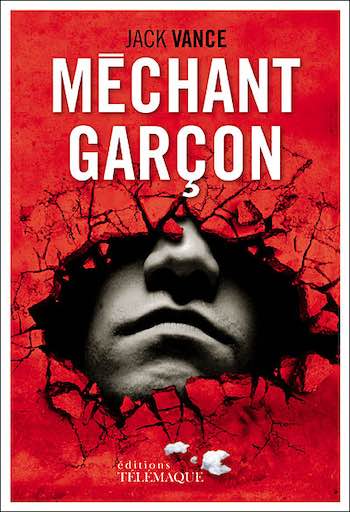Read in Jack Vance’s ‘Bad Ronald’ :
— I know I have at least two minds in me that work non-stop. Sometimes I disconnect the one above to be able to realize what the one below will do. I assure you that some very interesting things are happening. This is a game that I recommend when you have time.
Should we see it as the simple expression of conscious/unconscious dualism? Not so simple. The formulation contains two additional clues: 1) One of the two minds appears only by extinguishing the other. 2) The mental process has two directions, asymmetrical. The ascendant (from below to above) is permanently active. The descendant can be disconnected. Jack Vance describes in 1973 the double look, that of the mental micromechanisms that are proposed to the consciousness and that of the mind above, which I call the Observer, controller of these suggestions according to rules that belong only to it.
In ‘The Schopenhauer Cure’, Irvin Yalom…
… describes the case of Philip Slate, a brilliant chemist who is as lonely as he is obsessive about sex. He multiplies coitus with partners for a day, only interested in the immediate sequelae: his mind temporarily frees itself from obsession and can devote itself to reading. Philip’s psychotherapy by Julius, a highly trained psychiatrist, is a fiasco, despite the patient’s goodwill. Julius explores Philip’s personal story, but finds no hook. After 3 years Philip abruptly interrupts the sessions, disappointed. We find Julius 22 years later. He learns that a melanoma condemns him to the medium term and wonders about the usefulness of his past existence. He remembers Philip, the only radical failure of his career, and reconnects with him.
He discovers with amazement that Philip has become a psychotherapist himself, or rather a philosopher therapist. His former patient makes no difficulty filling in the blanks. Other psychiatrists have also been disappointing. He left his flourishing position as a chemist, which no longer interested him, and turned to philosophy. The enlightenment came from a novel by Thomas Mann, whose character, on the verge of death, escapes despair by reading Schopenhauer. This author’s discovery finally cures Philip’s obsession. In Julius’ eyes, however, he has not changed his personality: acute intelligence combined with a complete lack of empathy. What happened?
The failure of downward therapy
Julius tried to correct an uncontrollable impulse in Philip, persuading him that it was abnormal. Downward therapy: Julius’s Observer decrees that there is a problem in mental micromechanisms and pulls out his toolkit. But there is no such problem. Philip’s impulses are normal. We will see in a moment why they take this radical turn. Julius’ tools can’t find any bolts to tighten. His patient’s mind is perfectly functional, as Philip himself experiences.
Julius went in the wrong direction. Adapted therapy is upward. Philip’s impulses must find their own organization, build a sophisticated Observer, capable of redirecting them. This ‘mind above’, in Philip, is indeed embryonic, a mere mirror of those around him, unable to provide an explanation for his being. Philip eventually understood it outside the cabinets, reading the great thinkers. He fleshes out his ‘mind from above’ book after book, especially with those who offer a greater outlet to his impulses.
Empathy cannot be invented
They are normal, we said. But why so imperative? The reason lies directly in Philip’s lack of empathy. He is an impulsive individual like the others, but not within a society of similar beings. Partners are receptacles. The collective < > individual setting, at Philip, is positioned radically on individual. This setting is given to him. Impossible to change. We can distribute our empathy according to the circumstances, but not give it to life from a void. Micromechanism is absent at Philip. All he has to do is to adapt.
Like most people in his situation, he can represent the feelings of others without experiencing them. As if he gave wavelengths to light without ever having seen any color. This patient work ultimately allows him to emancipate himself from the unexpected emotional reactions of his congeners. They no longer disturb him.
Important note: Philip’s weakness of the upper mind did not prevent him from building an exceptional intelligence. This shows that these aspects of the mind are clearly independent. It is the depth of Philip’s neural complexity that makes his intelligence, and the lack of empathy that has made him obsessive, his impulses not finding collectivist injunctions to organize themselves into a complete personality.
Downward and upward pathologies
Here we are in front of the 2 main categories of mental disorders that I wanted you to discover:
1) Downward pathologies, the most frequent in everyday life, are related to an awkward Observer, too present, or depreciator. The person continually examines herself to the point of rarely experiencing things live. She swims in opinions that contradict her own feelings. And yet the Observer validates these sources, causing malfunctions. She forms myths about her own history. The treatment is downward, consisting in enriching the consciousness of more diverse concepts, breaking the fixations. Let us also know, as Jack Vance indicated, to disconnect our Observer.
2) Upward pathologies, the most frequent in psychiatry, are related to alterations in neural, genetic, neuro-hormonal, anatomical micromechanisms. Staged organization of the brain whose defects are immediately apparent at the base (neurological), less quickly in the middle (neuropsychiatric), late at the top (psychological).
The usual recommendations led Philip to a psychoanalyst, who would have been an excellent choice for a downward pathology. But his disorder is upward, explaining Julius’ distress and surprise when Philip heals himself without having changed his personality, and without any work on his unconscious.
*
Links:
Bad Ronald, Jack Vance
The Schopenhauer Cure, Irvin D. Yalom

